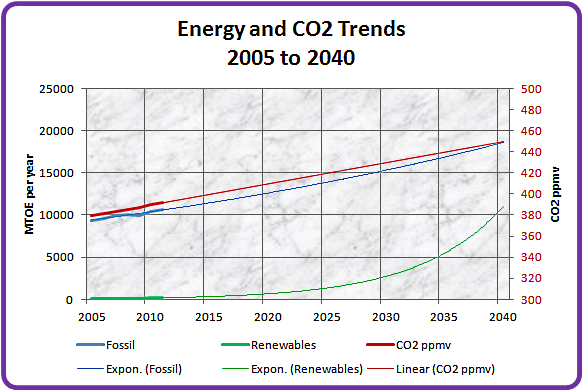Environment & Energy
Related: About this forumFossil Fuels vs. Renewables: How is the race unfolding?
When skeptics point out that fossil fuels are staying well ahead of renewable energy in the race to power the planet, the standard rebuttal is that because the renewable industry is so new, its rate of introduction is increasing dramatically as time goes on. This post is my attempt to investigate the validity of that rebuttal.
My technique was to do a set of trend projections based on the actual energy consumption data over three time periods: 1990 to 2011, 2000 to 2011, and 2005 to 2011. In each case the projection goes from 2012 to 2040. This allows us to see what future consumption might be if the actual consumption trend in that time period were to hold for the next 29 years. I also included atmospheric CO2 concentrations over the same periods, so we can also see the possible impact of renewables on CO2 buildup.
The endpoint values shouldn't be taken as predictions in any of the three cases. The important information is the trend differences based on older vs. more recent data.
As usual, the energy consumption data (oil+coal+NG and non-hydro renewables) is from the BP Statistical Review of World Energy 2012, and the CO2 data is from Scripps.



Renewables
If the trend from 1990 to 2011 had been followed, renewables would only be generating about 2000 mtoe (million tonnes of oil equivalent) by 2040. Based on the data from 2005 to 2011 however, they could be generating five times that much. The adoption of renewable energy has accelerated dramatically over the last 20 years.
Fossil fuels
Fossil fuels show a more stable trend, though there have obviously been wobbles over the last 20 years. The trends for 2040 all show the same range of around 20,000 mtoe per year. One thing that stands out is the effect of the recession. The 2000-2011 trend shows more long-term growth than the 2005-2011 trend. That is because the effect of the 2008-2009 recession is amplified when it's part of the smaller 6-year data set of 2005-2011, compared to the 11 years of 2000-2011.
CO2
The worrying thing is that CO2 concentration trend remains stubbornly fixed despite the improving trend of renewables. That is probably due to the fact that the use of fossil fuels is not yet declining in response to the introduction of renewables.
The signs are good, but much remains to be done.
kristopher
(29,798 posts)Your "investigation" pretends this isn't happening:
http://www.renewableenergyworld.com/rea/news/article/2012/06/renewables-make-german-power-market-design-defunct-utility-says?cmpid=SolarNL-Thursday-June28-2012
That "market design" being referenced means "centralized thermal", the design built around coal and nuclear. So this is a description of renewable energy in the first and most critical stage of putting fossil fuel generation out of business as a new "market design" centered around distributed renewables takes form.
If you are serious about climate change, this is what you've been waiting to see happen.
http://www.democraticunderground.com/112718851
Or this:
"...In March, the power generating arm of India’s largest conglomerate, the Tata Group, announced that it was shifting its investment strategy from coal-fired thermal plants to wind and solar renewable projects. Coal projects, Tata said, were becoming “impossible” to develop, and investment in them had stopped.
With this declaration, one of Asia’s biggest energy players confirmed an emerging reality. The U.S., Europe, Russia, Australia and Japan all had created modern consumer economies dependent on abundant, cheap fossil-fuel energy. In the 21st century that is no longer viable; the high-carbon growth path is closing...."
http://www.democraticunderground.com/112718437
See also:
http://www.democraticunderground.com/112715268
And:
http://www.nrel.gov/analysis/re_futures/
Renewable Electricity Futures Study
A report published by the National Renewable Energy Laboratory (NREL), the Renewable Electricity Futures Study (RE Futures), is an initial investigation of the extent to which renewable energy supply can meet the electricity demands of the continental United States over the next several decades. This study explores the implications and challenges of very high renewable electricity generation levels—from 30% up to 90%, focusing on 80%, of all U.S. electricity generation from renewable technologies—in 2050. At such high levels of renewable electricity generation, the unique characteristics of some renewable resources, specifically geographical distribution and variability and uncertainty in output, pose challenges to the operability of the nation's electric system.
Key Findings
Renewable electricity generation from technologies that are commercially available today, in combination with a more flexible electric system, is more than adequate to supply 80% of total U.S. electricity generation in 2050 while meeting electricity demand on an hourly basis in every region of the country.
Increased electric system flexibility, needed to enable electricity supply-demand balance with high levels of renewable generation, can come from a portfolio of supply- and demand-side options, including flexible conventional generation, grid storage, new transmission, more responsive loads, and changes in power system operations.
The abundance and diversity of U.S. renewable energy resources can support multiple combinations of renewable technologies that result in deep reductions in electric sector greenhouse gas emissions and water use.
The direct incremental cost associated with high renewable generation is comparable to published cost estimates of other clean energy scenarios. Improvement in the cost and performance of renewable technologies is the most impactful lever for reducing this incremental cost.
<snip>
http://www.democraticunderground.com/112718362
GliderGuider
(21,088 posts)The past interaction has been essentially nil, especially when considered on a global scale.
However, recent signs are encouraging.